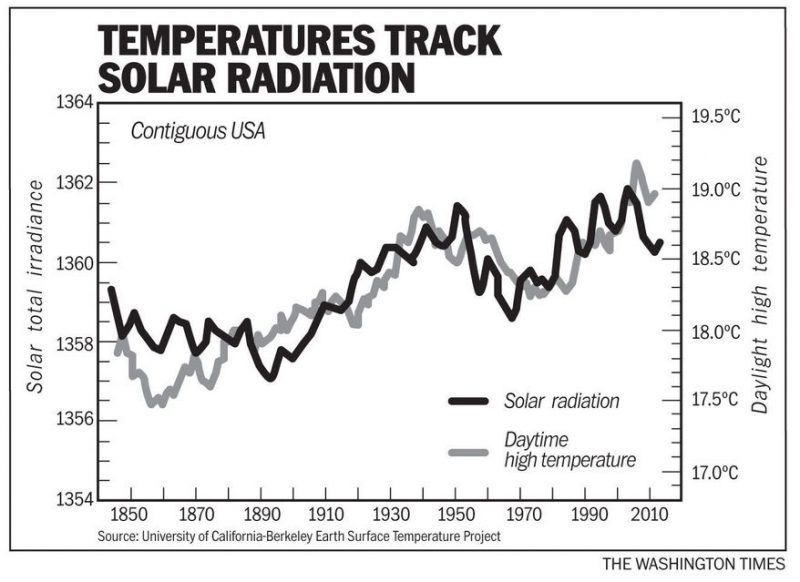Scientists have been studying solar influences on the climate for more than 5,000 years.
Chinese imperial astronomers kept detailed sunspot records. They noticed that more sunspots meant warmer weather. In 1801, the celebrated astronomer William Herschel (discoverer of the planet Uranus) observed that when there were fewer spots, the price of wheat soared. He surmised that less light and heat from the sun resulted in reduced harvests.
Earlier last month, professor Richard Muller of the University of California-Berkeley Earth Surface Temperature (BEST) project announced that in the project’s newly constructed global land temperature record, “no component that matches solar activity” was related to temperature. Instead, Mr. Muller said carbon dioxide controlled temperature.
Could it really be true that solar radiation — which supplies Earth with the energy that drives our climate and which, when it has varied, has caused the climate to shift over the ages — is no longer the principal influence on climate change?
Consider the accompanying chart. It shows some rather surprising relationships between solar radiation and daytime high temperatures taken directly from Berkeley’s BEST project. The remarkable nature of these series is that these tight relationships can be shown to hold from areas as large as the United States.

This new sun-climate relationship picture may be telling us that the way our sun cools and warms the Earth is largely through the penetration of incoming solar radiation in regions with cloudless skies. Recent work by National Center for Atmospheric Research senior scientists Harry van Loon and Gerald Meehl place strong emphasis on this physical point and argue that the use of daytime high temperatures is the most appropriate test of the solar-radiation-surface-temperature connection hypothesis. All previous sun-climate studies have included the complicated nighttime temperature records while the sun is not shining.
Even small changes in solar radiation may have a strong effect on Earth’s temperature and climate. In 2005, one of us demonstrated a surprisingly strong correlation between solar radiation and temperatures in the Arctic over the past 130 years. Since then, we have demonstrated similar correlations in all the regions surrounding the Arctic, including the U.S. mainland and China. The confirmation of a sun-temperature relation using only the daytime-high-temperature records from the United States certainly adds scientific weight to the soundness of this connection.
The close relationships between the abrupt ups and downs of solar activity and of temperature that we have identified occur locally in coastal Greenland, regionally in the Arctic Pacific and North Atlantic; and hemispherically for the whole circum-Arctic, suggesting that changes in solar radiation drive temperature variations in at least many areas.
Pictures like these cannot be drawn for temperature and CO2 concentration. There just is no such close match between the steady rise in atmospheric CO2 concentration and the often dramatic ups and downs of surface temperatures in and around the Arctic, China and the United States.
Even more recently, in collaboration with professor David Legates of the University of Delaware, we were able to provide a self-consistent explanation for these observed apparent sun-climate correlations, which involves the exchange of heat and moisture between the equator and the Arctic region. In addition, we recently discovered direct evidence that changes in solar activity have influenced what has been called the “conveyor belt” circulation of the great Atlantic Ocean currents over the past 240 years. For instance, solar-driven changes in temperature and in the volume of freshwater output from the Arctic cause variations in sea surface temperature in the tropical Atlantic five to 20 years later.
These peer-reviewed results, appearing in several science journals, make it difficult to maintain that changes in solar activity play no or an insignificant role in climate change.
The hallmark of good science is the testing of plausible hypotheses that are either supported or rejected by the evidence. The evidence in BEST’s own data and in other data we have analyzed is consistent with the hypothesis that the sun causes climate change, especially in the Arctic, China and the United States. BEST’s data also clearly invalidate the hypothesis that CO2 is the most important cause of observed temperature changes across the United States.
Given the wide, and perhaps at times excessive, interest in tying carbon dioxide to climate, there has been relatively little work investigating the solar-climate connection. The scientific community has proved the wisdom of Ralph Waldo Emerson, who said, “The sun shines and warms and lights us and we have no curiosity to know why this is so.”
Willie Soon has been researching the relationship of solar radiation and Earth’s climate for the past 22 years. William M. Briggs is a meteorology-trained statistician and former associate editor of the Monthly Weather Review.
